
Shot Craft: Diffusion Confusion - Part 1
Diffusion filters — also referred to as “gels” — are the most common tools for altering the quality of light sources. We tested a number of regularly used diffusions and see what their exact effects really are.
Manufacturers including Lee Filters, Gam Products and Gam’s parent company Rosco create and sell a wide variety of these kinds of filters. Understanding the differences between them — and knowing when to choose one over another — has perplexed many cinematographers and gaffers over the years. In many cases, they have experience with one particular “flavor” of diffusion, and they opt to stick with it throughout their career. There’s nothing wrong with that approach, but in an effort to clarify this diffusion confusion, I teamed up with cinematographer Kaity Williams to test a number of regularly used diffusions and see what their exact effects really are.
The primary job of a lighting-diffusion filter is to break up direct, hard rays of light from a source and scatter them to create a softer source. In order to discuss the effects of these filters, we need to define the attributes that we’ll be examining.
The first is the shadow edge transfer, where light transitions to shadow on a subject. The softer the source, the larger this area of transition will be. A sharp, well-defined transfer value indicates a hard light. A completely overcast sky, on the other hand, is the ultimate soft light; in this instance, nearly all shadows are eliminated, and the transfer from light to shadow is extremely long and gradual — and almost indiscernible.
The softness of light is primarily determined by the size of the source relative to the source’s distance from the subject. While the sun is a huge light source, it’s also roughly 93 million miles away from us on Earth; as a result of that distance, it’s a very hard source of light that creates very sharp, well-defined shadows. When clouds cover the sky, they become the new apparent light source, and the size of the source increases from a small sphere — the distant sun — to the entire visible sky itself. That’s an important point: When we put diffusion in front of a light source, the diffusion effectively becomes the new light source. The same is true when we bounce light into something; the material we’re bouncing into becomes the new source for our subject. The larger that source is, relative to the subject, the softer the light will be.
Assuming all diffusion filters are the same size, the same distance from the subject, and the same distance from the source, then the more opaque the material, the more it will diffuse the light, creating a softer source. This can be clearly seen if you look at the diffusion itself to see the light source shining behind it. The more defined that light source is to your eye, the less softening effect that diffusion will have on the source, and the harder the overall light will be.

Next, a shadow isn’t just a shadow. It’s actually made up of two components: the umbra and the penumbra (see diagram above). The umbra of a shadow is the deep, dark center of it. If your light source is a point source from a distance, and there’s nothing nearby to scatter and fill in that light, then your shadow will be pure umbra, sharp and well-defined. The penumbra is the secondary portion of the shadow, the “fuzzy” perimeter created by oblique rays of light coming around the edges of the subject. Hard light has a very small penumbra or none at all; soft light has a very large penumbra, with little or no umbra.
To conduct our experiment, Williams and I set up two different tests: one with a series of three-dimensional geometric shapes placed on a grid pattern, the other with a mannequin head surrounded by black. With the former, the various shapes help to clearly illustrate the umbra and penumbra created by each of the various diffusion materials — the larger the penumbra, the larger the shadow edge transfer and the softer the light source. “You’ll also notice that as the source gets softer, the length of the shadow is reduced,” offers Williams. “The penumbra is becoming so large that it is overtaking the umbra.
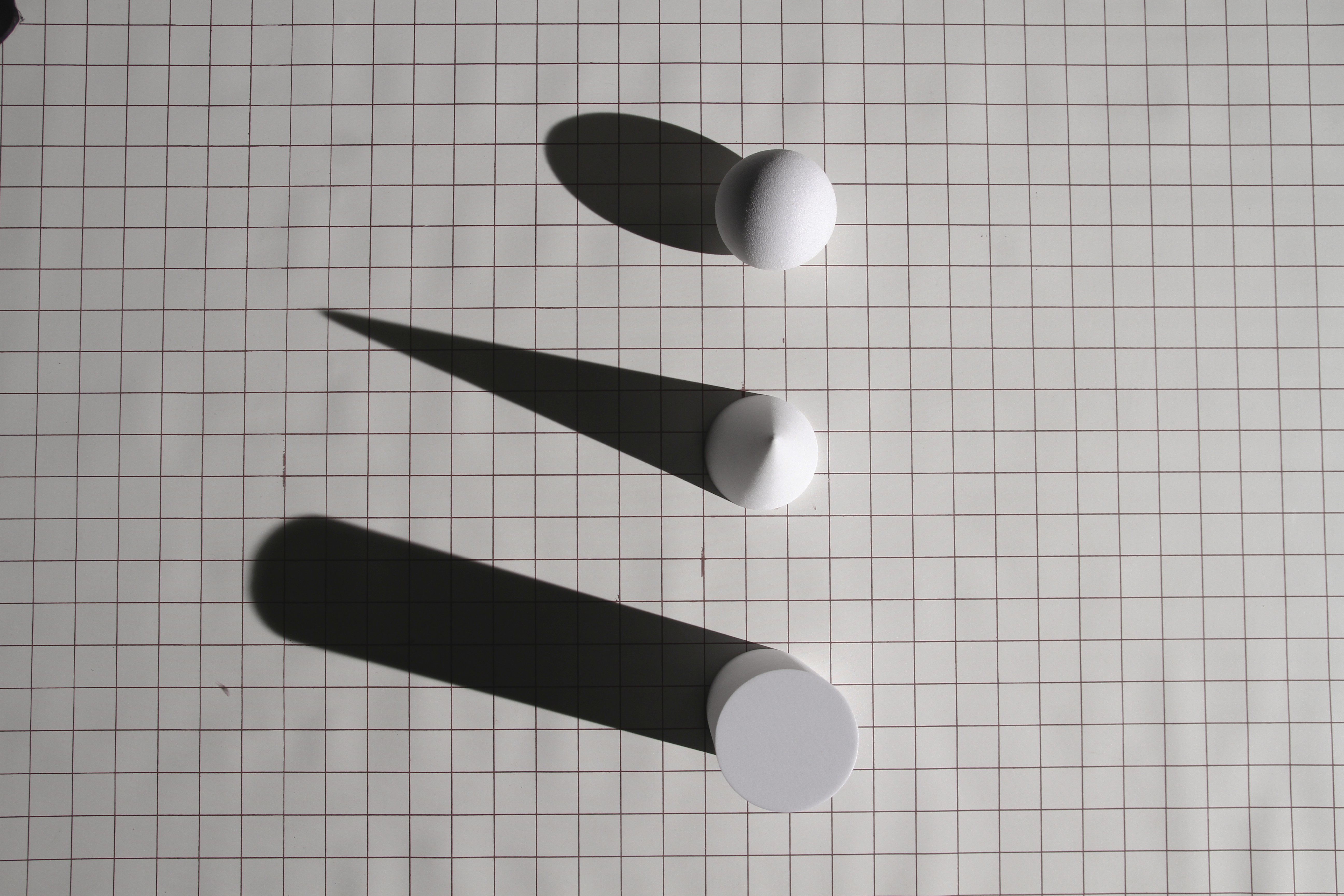



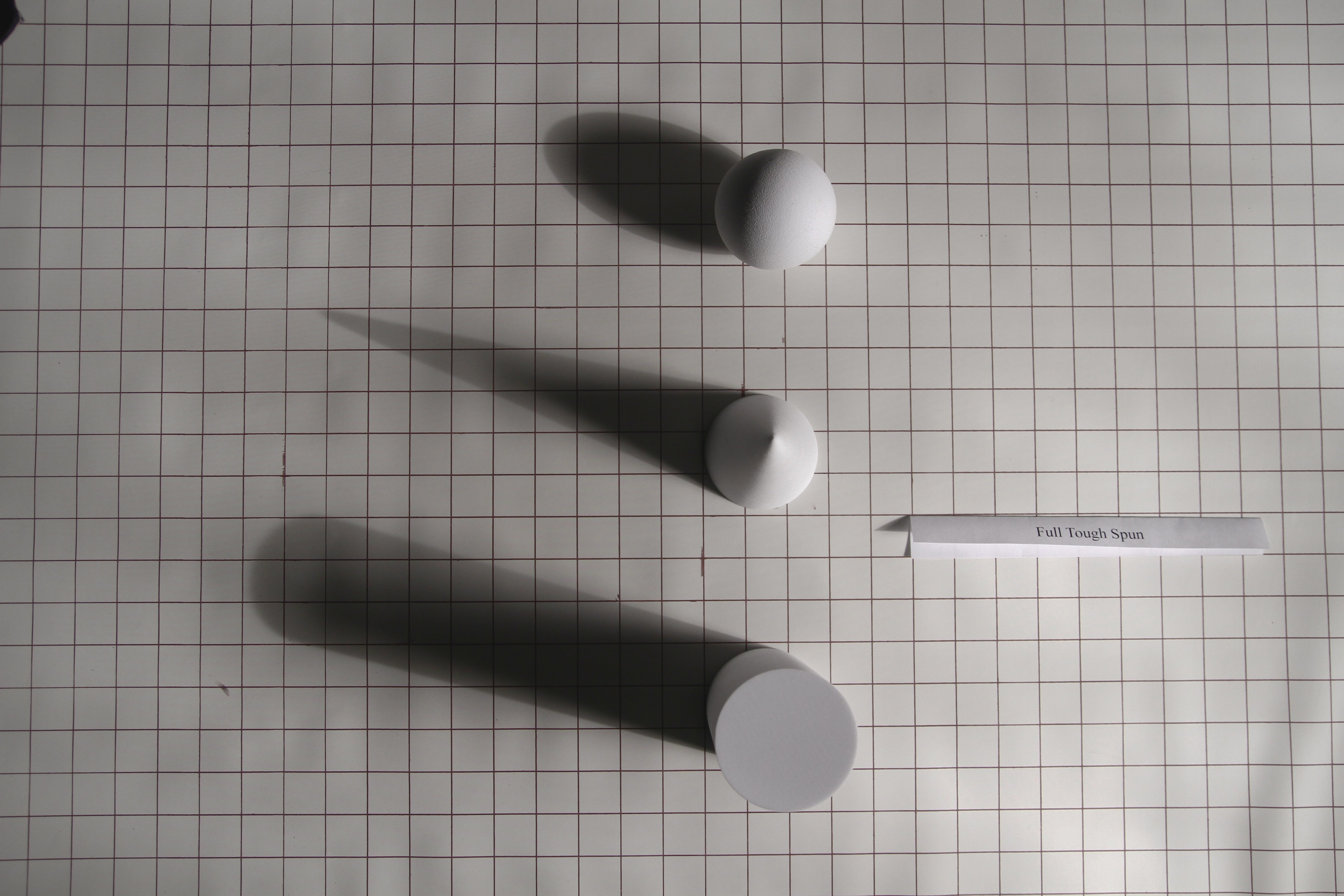

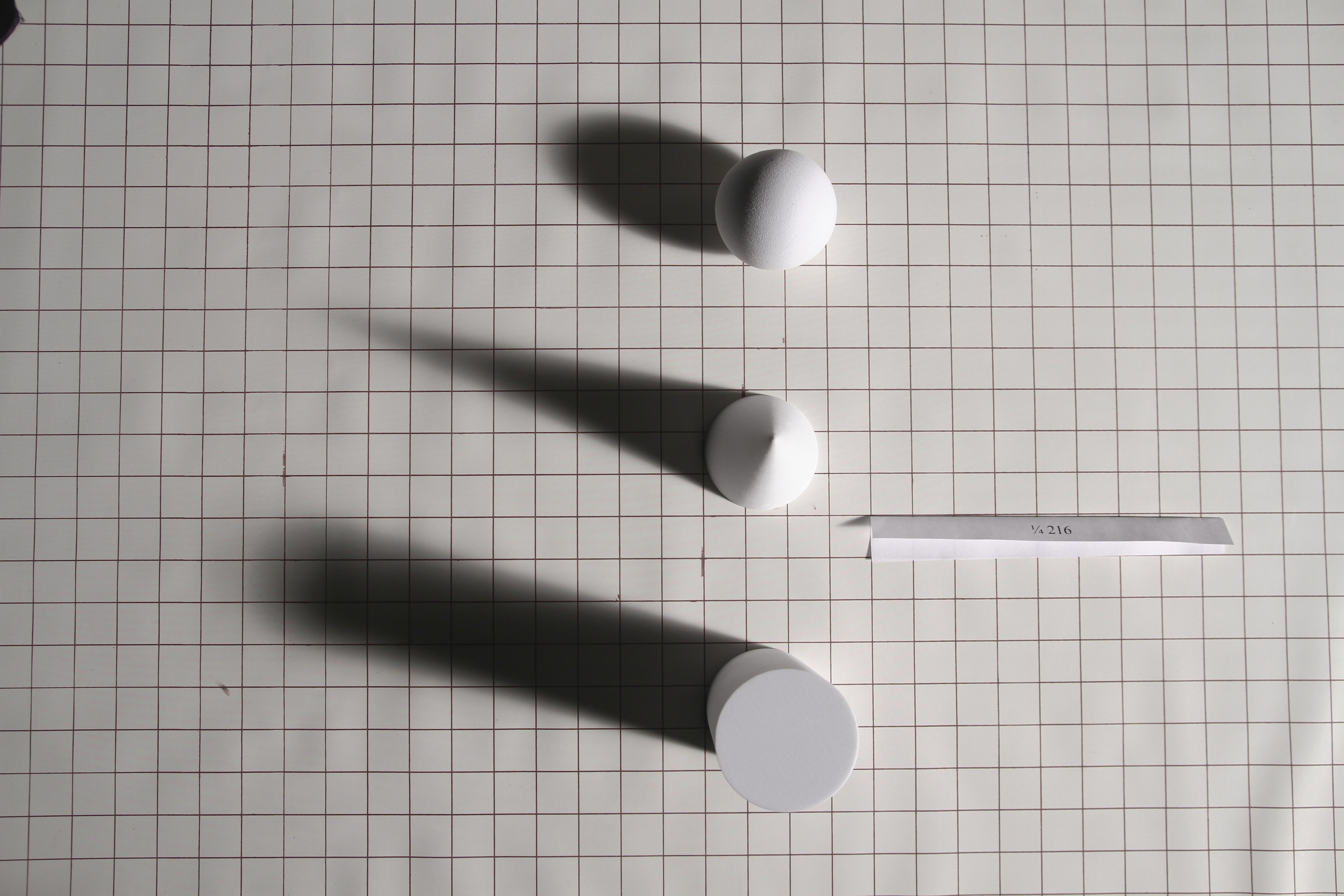


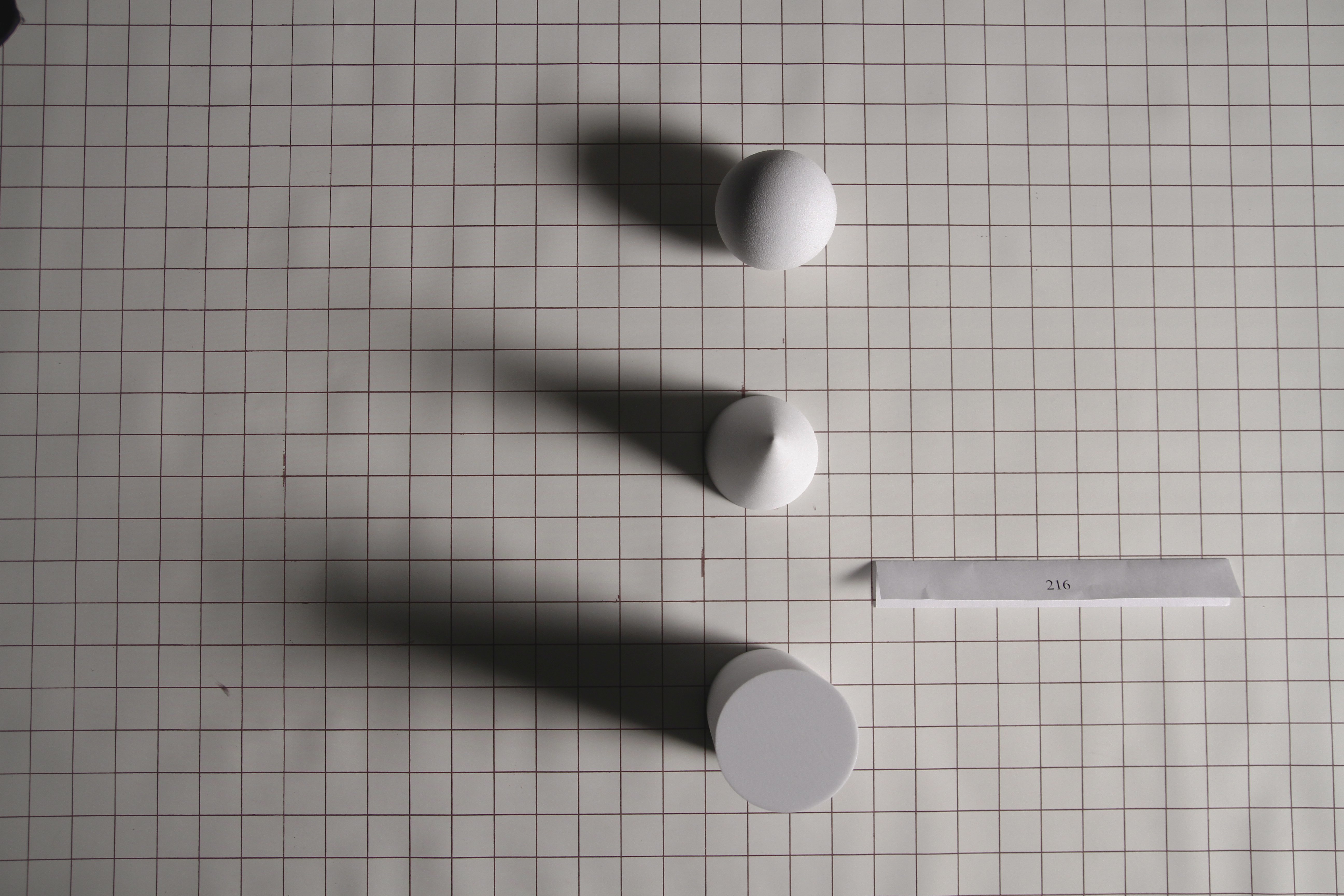

Looking at the effects of each diffusion from the least amount of softening to the most, we see the shadow transfer value changing significantly as we increase the opacity of the diffusion — with the exception of the Spun options, where the shadow remains hard but loses contrast. By the time we get to Full Grid Cloth, the shadow is a fraction of the size of the hard light, and the penumbra is nearly indiscernible from the ambient light.
“Both tests were lit with an Arri 1K Fresnel from a distance of about 10 feet,” Williams explains. “Each of the diffusions we tested were placed at 4 feet from the subject — either the shapes or the mannequin head — so that the light from the 1K completely filled the diffusion area. Each piece of diffusion we tested was 4-feet-wide by 4-feet-tall. So we were turning a 6-inch Fresnel lens 10 feet away into a 4-by-4-foot source 4 feet away from our subject. Closer and larger should make for a softer source.”
Each iteration was metered for color and illumination, and the results are listed in the chart below. The light fixture itself was never adjusted during the series of tests; the only alteration was to change the diffusion, which was placed in the same position each time.

Anything put in the path of a light source will alter the light; diffusion will always both absorb and reflect a certain amount of light from the source, as well as take focused light and scatter it. This means there’s always some loss of light through diffusion. Logically, the more opaque the diffusion is, the greater the loss of light.
“One other thing we noted was the color difference of each type of diffusion,” continues Williams. “Because most diffusion is ‘white,’ we usually think of it as being ‘neutral’ in color, but that isn’t really the case. Nearly every diffusion we tried altered the color temperature of the source slightly.”
The camera was set to a color balance of 3200K, and no attempt was made to color-correct any of the images. “Some of the diffusion had very little effect on the color, but others, like the Full Grid Cloth, caused a pretty noticeable change in color temperature,” Williams notes.
The diffusions we tested are among the most common in the industry and are manufactured by multiple companies; Rosco Laboratories generously supplied all of the diffusion for our test. In order from the hardest resulting light to the softest, the types we tested were: 1⁄4 Tough Spun, Light Tough Spun, Light Opal, Full Tough Spun, Opal, 1⁄4 216, 1⁄2 216, 1⁄4 Grid Cloth, 216 and Full Grid Cloth.



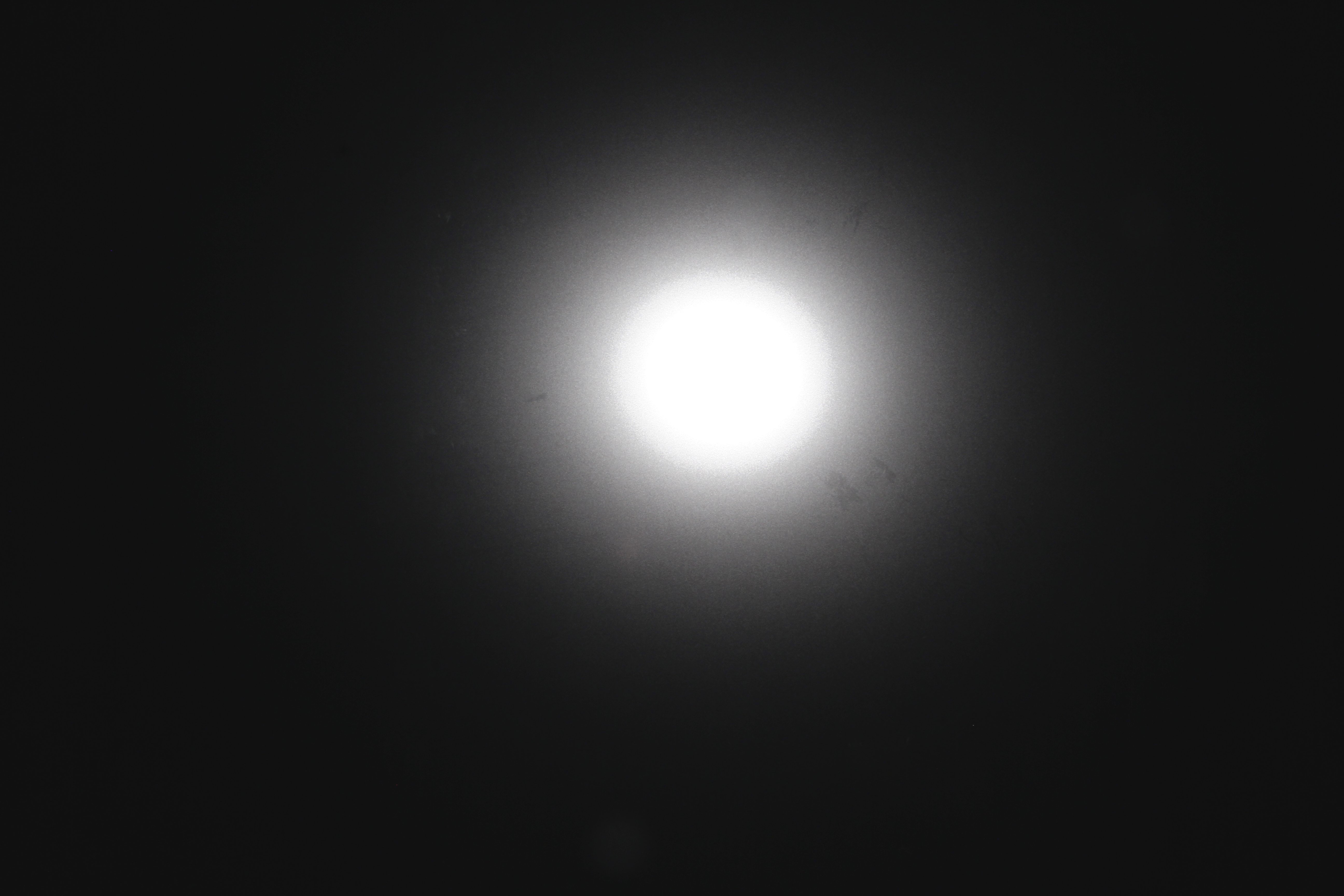







Looking at the light source itself through the diffusion we can clearly see how a combination of direct light and diffuse light creates a harder source (as in the Spun and Opal options). As the definition of the original light source becomes increasingly obfuscated by the diffusion material, the overall size of the source increases and the quality of light is softened substantially.
The Tough Spun has very interesting properties. As it is a fine pattern of thin threads, there are clear spots along the material where direct light can shine through. This means that it produces a combination of both hard and diffuse light. You can see this illustrated in the images of the geometric shapes from our test, as both the umbra and penumbra of the shadows are well-defined.
“Tough Spun doesn’t really change the shadow transfer value [from that of a hard-light source],” notes Williams. “The shadows are still sharp, with just a reduction in contrast. All three of the Tough Spun strengths have this same behavior. This effect is clearest in the heaviest of the three, Full Tough Spun, where the penumbra has a clean, hard line, and the umbra of the shadow, although diminished, is still clearly defined. The Light Opal, on the other hand — as minimal an effect as it might have — starts to produce a breakdown in the definition of the penumbra, denoting more softness to the light.
“It was very interesting to me that the Tough Spun lent a texture to the light, a lot like a cookie or a celo cookie,” Williams continues. “It’s subtle, but it does project a pattern onto the subject.” As with any projected pattern, the farther away the pattern-producing material is from the light source, the better-defined the pattern will be on the subject.
The amount of diffusion increases with 1⁄4 216, which, we can see, produces very similar effects in terms of shadow quality to 1⁄2 216 and 1⁄4 Grid Cloth. Full Grid Cloth and 216 also produce very similar effects to one another, although Full Grid Cloth offers more diffusion of the light, as can be seen in the more diffuse penumbra; the definition of the shape is almost completely gone.
To further understand how diffusion works, we need to take a look at the material itself and see our light source behind it. The quality of light is created by the size of the light source relative to the subject, but if our diffusion material isn’t wholly opaque and we can still see some of the original source behind that material, then the actual fixture — in addition to the “new” light source created by the diffusion — has an effect on the overall quality of light. This is how lighter diffusions, even at the same size and placed at the same distance to the subject, create light that is less soft than what results from heavier diffusions — because they effectively combine the scattered light of the new apparent light source with the direct light of the original source, which is farther away and smaller.
Notice that the 216 and Full Grid Cloth almost completely obliterate the light source behind it, but the Grid Cloth is more effective at eliminating all shape from the original source — and, therefore, it makes for softer light. Both diffusions, however, completely become the new apparent light source. Looking at the Light Opal, we see a clearly defined source behind the diffusion material; its significantly lighter opacity allows for more direct light to pass through with only subtle scattering, hence a harder overall source. The 1⁄4 Grid Cloth has an interesting property of “streaking” light, due to its grid-pattern texture, but we did not notice this resulting in any particular effect on the subjects we lit or the shadows they cast.











The effect of the diffusions on an analog of the human face. Looking at the shadow cast by the nose onto the cheek, we can clearly see the differences each diffusion offers to the quality of light. With some of these diffusions, the results are so similar that they are, in effect, indistinguishable in a practical sense. The pattern from the spun materials can be seen in the background fairly clearly.
Looking at the mannequin head, we can see that the differences in the quality of light from each diffusion are significantly subtler than one might imagine. Here we want to examine the shadow edge transfer, which is most clearly delineated by the nose shadow and where it meets — or doesn’t meet — the cheek shadow. Though the differences can be extremely subtle — and, arguably, indiscernible in a practical situation — there are differences between each. Even 216 and Full Grid Cloth are different; the density of the shadow on the cheek of the mannequin is lighter with the Grid Cloth, denoting that it is scattering more light than the 216. Remember, when we look at the shots of the diffusion itself, we see that the Grid Cloth is more effective than the 216 at obliterating the shape of the light fixture. While both diffusions are effective, the Grid Cloth offers more diffusion than the 216 — at the expense of 2⁄3 more loss of light.
Additionally, the actual material is different from one type of diffusion to the next. Grid Cloth can be sewn together; 216, which is more plastic-like, cannot. In a windy situation, 216 is louder than Grid Cloth — and Silent Frost, which we did not test here, is an even quieter option. If you like the shadow sharpness of hard light but want to reduce the contrast of the shadows, Tough Spun is your choice — although it comes with a slight pattern, which here can best be seen on the backdrop behind the mannequin. Light Opal and 1⁄4 216 are so close to each other that the differences in a practical application would be, well, practically nothing.
“It’s important to know exactly how you want to alter the light to achieve the look you’re going for,” concludes Williams. “That’s why it’s vital to understand what these diffusion filters are actually doing. Through this test, I’ve definitely come to understand a lot more about the ways each filter can alter the shadow and overall quality of light. It was impressive to see how different the effects of these filters were, even though the filters were the same size and same distance from the light source. I’m looking forward to what can be discovered from the next test!”
In an upcoming Shot Craft, we’ll take a look at other aspects that Williams and I tested, including bounce sources and alternative diffusion materials compared to these more common choices.
Special thanks to Joel Svendsen from Rosco for generously supplying the materials for this test.
You'll find Part 2 of this report here.





